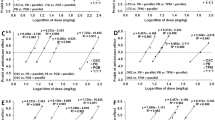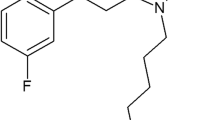Abstract
The aim of this study was to characterise the types of interactions between gabapentin (GBP), tiagabine (TGB) and three second-generation antiepileptic drugs (AEDs) with different mechanisms of action (felbamate [FBM], loreclezole [LCZ], and oxcarbazepine [OXC]) by isobolographic analysis. Anticonvulsant and acute neurotoxic adverse effect profiles of combinations of GBP and TGB with other AEDs at fixed ratios of 1:3, 1:1 and 3:1 were investigated in pentylenetetrazole (PTZ)-induced seizures and the chimney test (as a measure of motor impairment) in mice so as to identify optimal combinations. Protective indices (PIs) and benefit indices (BIs) were calculated for each combination in order to properly classify the investigated interactions. Isobolographic analysis revealed that only the combination of GBP with OXC at the fixed ratio of 1:1 exerted supra-additive (synergistic) interaction (P<0.05) against PTZ-induced seizures. The other combinations tested between GBP and OXC (1:3 and 3:1), as well as all combinations of GBP with FBM or LCZ (1:3, 1:1 and 3:1) were additive in the PTZ test. Similarly, all combinations of TGB with FBM LCZ, and OXC (at the fixed ratios of 1:3, 1:1 and 3:1) were associated with additive interactions against PTZ-induced seizures in mice. In the chimney test, the isobolographic analysis revealed that the combinations of GBP and OXC (at the fixed ratios of 1:3 and 1:1), GBP and LCZ (at 1:1), as well as TGB and OXC (at 1:3 and 1:1) were sub-additive (antagonistic; P<0.05 and P<0.01). In contrast, only one combination tested (TGB and LCZ at the fixed ratio of 1:1) was supra-additive (synergistic; P<0.05) in the chimney test, whereas the other combinations of GBP and TGB with OXC, FBM, and LCZ displayed barely additivity. Based upon the current preclinical data, GBP and OXC appear to be a particularly favourable combination. Also, the combinations of GBP with FBM, GBP with LCZ, and TGB with OXC are beneficial. In contrast, during the combining of TGB with FBM, or TGB with LCZ, the utmost caution is advised because of their unfavourable profiles in this preclinical study.




Similar content being viewed by others
Abbreviations
- AED:
-
Antiepileptic drug
- BI:
-
Benefit index
- CNS:
-
Central nervous system
- ED50:
-
Median effective dose
- FBM:
-
Felbamate
- GABA:
-
γ-Aminobutyric acid
- GBP:
-
Gabapentin
- LCZ:
-
Loreclezole
- OXC:
-
Oxcarbazepine
- PI:
-
Protective (therapeutic) index
- PTZ:
-
Pentylenetetrazole
- TD50:
-
Median toxic dose
- TGB:
-
Tiagabine
- VGB:
-
Vigabatrin
References
Arroyo S, Brodie MJ, Avanzini G, Baumgartner C, Chiron C, Dulac O, French JA, Serratosa JM (2002) Is refractory epilepsy preventable? Epilepsia 43:437–444
Berenbaum MC (1989) What is synergy? Pharmacol Rev 41:93–141; erratum in (1990) Pharmacol Rev 41:422
Boissier JR, Tardy J, Diverres JC (1960) Une nouvelle méthode simple pour explorer l’action tranquilisante: le test de la cheminée. Med Exp (Basel) 3:81–84
Borowicz KK, Swiader M, Luszczki J, Czuczwar SJ (2002) Effect of gabapentin on the anticonvulsant activity of antiepileptic drugs against electroconvulsions in mice—an isobolographic analysis. Epilepsia 43:956–963
Borowicz KK, Luszczki JJ, Czuczwar SJ (2004) Isobolographic and subthreshold analysis of interactions among felbamate and four conventional antiepileptic drugs in pentylenetetrazole-induced seizures in mice. Epilepsia 45:1176–1183
Brodie MJ, Schachter SC (2001) Fast facts. Epilepsy, 2nd edn. Health Press, Oxford, p 82
Coenen AM, Blezer EH, van Luijtelaar EL (1995) Effects of the GABA-uptake inhibitor tiagabine on electroencephalogram, spike-wave discharges and behaviour of rats. Epilepsy Res 21:89–94
Czuczwar SJ, Patsalos NP (2001) The new generation of GABA enhancers. Potential in the treatment of epilepsy. CNS Drugs 15:339–350
Deckers CLP, Czuczwar SJ, Hekster YA, Keyser A, Kubova H, Meinardi H, Patsalos P, Renier WO, van Rijn CM (2000) Selection of antiepileptic drug polytherapy based on mechanism of action: the evidence reviewed. Epilepsia 41:1364–1374
De Sarro G, Ongini E, Bertorelli R, Aguglia U, De Sarro A (1994) Excitatory amino acid neurotransmission through both NMDA and non-NMDA receptors is involved in the anticonvulsant activity of felbamate in DBA/2 mice. Eur J Pharmacol 262:11–19
Donnelly JL, Macdonald RL (1996) Loreclezole enhances apparent desensitization of recombinant GABAA receptor currents. Neuropharmacology 35:1233–1241
Gee NS, Brown JP, Dissanayake VUK, Offord J, Thurlow R, Woodruff GN (1996) The novel anticonvulsant drug, gabapentin (neurontin), binds to the alpha2delta subunit of calcium channel. J Biol Chem 271:5768–5776
Genton P (2000) When antiepileptic drugs aggravate epilepsy. Brain Dev 22:75–80
Goldlust A, Su TZ, Welty DF, Taylor CP, Oxender DL (1995) Effects of anticonvulsant drug gabapentin on the enzymes in metabolic pathways of glutamate and GABA. Epilepsy Res 22:1–11
Greco WR, Bravo G, Parsons JC (1995) The search for synergy: a critical review from a response surface perspective. Pharmacol Rev 47:331–385
Haugvicova R, Kubova H, Mares P (1999) Antipentylenetetrazol action of clobazam in developing rats. Physiol Res 48:501–507
Jonker DM, Vermeij DA, Edelbroek PM, Voskuyl RA, Piotrovsky VK, Danhof M (2003) Pharmacodynamic analysis of the interaction between tiagabine and midazolam with an allosteric model that incorporates signal transduction. Epilepsia 44:329–338
Kohling R, Konig K, Lucke A, Mayer T, Wolf P, Speckmann EJ (2002) Pre- rather than co-application of vigabatrin increases the efficacy of tiagabine in hippocampal slices. Epilepsia 43:1455–1461
Kwan P, Brodie MJ (2000a) Early identification of refractory epilepsy. N Engl J Med 342:314–319
Kwan P, Brodie MJ (2000b) Epilepsy after the first drug fails: substitution or add-on? Seizure 9:464–468
Leach JP, Brodie MJ (1994) Synergism with GABAergic drugs in refractory epilepsy. Lancet 343:1650
Leach JP, Sills GJ, Majid A, Butler E, Carswell A, Thompson GG, Brodie MJ (1996) Effects of tiagabine and vigabatrin on GABA uptake into primary cultures of rat cortical astrocytes. Seizure 5:229–234
Leach JP, Sills GJ, Butler E, Forrest G, Thompson GG, Brodie MJ (1997) Neurochemical actions of gabapentin in mouse brain. Epilepsy Res 27:175–180
Litchfield JT, Wilcoxon F (1949) A simplified method of evaluating dose-effect experiments. J Pharmacol Exp Ther 96:99–113
Löscher W, Nolting B (1991) The role of technical, biological and pharmacological factors in the laboratory evaluation of anticonvulsant drugs. IV. Protective indices. Epilepsy Res 9:1–10
Löscher W, Schmidt D (1988) Which animal models should be used in the search for new antiepileptic drugs? A proposal based on experimental and clinical considerations. Epilepsy Res 2:145–181
Löscher W, Wauquier A (1996) Use of animal models in developing guiding principles for polypharmacy in epilepsy. Epilepsy Res Suppl 11:61–65
Löscher W, Honack D, Fassbender CP, Nolting B (1991) The role of technical, biological and pharmacological factors in the laboratory evaluation of anticonvulsant drugs. III. Pentylenetetrazole seizure models. Epilepsy Res 8:171–189
Luszczki JJ, Czuczwar SJ (2003a) Isobolographic and subthreshold methods in the detection of interactions between oxcarbazepine and conventional antiepileptics—a comparative study. Epilepsy Res 56:27–42
Luszczki JJ, Czuczwar SJ (2003b) Isobolographic assessment of interactions between tiagabine and some newer antiepileptic drugs in pentylenetetrazole-induced seizures in mice [abstract]. Pol J Pharmacol 55:500–501
Luszczki JJ, Czuczwar SJ (2004a) Isobolographic profile of interactions between tiagabine and gabapentin: a preclinical study. Naunyn Schmiedebergs Arch Pharmacol 369:434–446
Luszczki JJ, Czuczwar SJ (2004b) Preclinical profile of combinations of some second-generation antiepileptic drugs: an isobolographic analysis. Epilepsia 45:895–907
Luszczki JJ, Borowicz KK, Swiader M, Czuczwar SJ (2003a) Interactions between oxcarbazepine and conventional antiepileptic drugs in the maximal electroshock test in mice: an isobolographic analysis. Epilepsia 44:489–499
Luszczki JJ, Czuczwar M, Kis J, Krysa J, Pasztelan I, Swiader M, Czuczwar SJ (2003b) Interactions of lamotrigine with topiramate and first-generation antiepileptic drugs in the maximal electroshock test in mice: an isobolographic analysis. Epilepsia 44:1003–1013
Luszczki JJ, Swiader M, Czuczwar M, Kis J, Czuczwar SJ (2003c) Interactions of tiagabine with some antiepileptics in the maximal electroshock in mice. Pharmacol Biochem Behav 75:319–327
Luszczki JJ, Swiader M, Parada-Turska J, Czuczwar SJ (2003d) Tiagabine synergistically interacts with gabapentin in the electroconvulsive threshold test in mice. Neuropsychopharmacology 28:1817–1830
Luszczki JJ, Andres MM, Czuczwar SJ (2005) Synergistic interaction of gabapentin and oxcarbazepine in the mouse maximal electroshock seizure model—an isobolographic analysis. Eur J Pharmacol 515:54–61
Mangano S, Cusumano L, Fontana A (2003) Non-convulsive status epilepticus associated with tiagabine in a pediatric patient. Brain Dev 25:518–521
McCabe RT, Wasterlain CG, Kucharczyk N, Sofia RD, Vogel JR (1993) Evidence for anticonvulsant and neuroprotectant action of felbamate mediate by strychnine-insensitive glycine receptors. J Pharmacol Exp Ther 264:1248–1252
Meldrum B (1995) Epilepsy. Taking up GABA again. Nature 376:122–123
Ng GY, Bertrand S, Sullivan R, Ethier N, Wang J, Yergey J, Belley M, Trimble L, Bateman K, Alder L, Smith A, McKernan R, Metters K, O’Neill GP, Lacaille JC, Hebert TE (2001) Gamma-aminobutyric acid type B receptors with specific heterodimer composition and postsynaptic actions in hippocampal neurons are targets of anticonvulsant gabapentin action. Mol Pharmacol 59:144–152
Nielsen EB, Suzdak PD, Anderson KE, Knutsen LJ, Sonnewald U, Braestrup C (1991) Characterization of tiagabine (NO-328), a new potent and selective GABA uptake inhibitor. Eur J Pharmacol 196:257–266
Olsen RW, Avoli M (1997) GABA and epileptogenesis. Epilepsia 38:399–407
Parker DAS, Ong J, Marino V, Kerr DIB (2004) Gabapentin activates presynaptic GABAB heteroreceptors in rat cortical slices. Eur J Pharmacol 495:137–143
Perucca E (1995) Pharmacological principles as a basis for polytherapy. Acta Neurol Scand Suppl 162:31–34
Porreca F, Jiang Q, Tallarida RJ (1990) Modulation of morphine antinociception by peripheral [Leu5]enkephalin: a synergistic interaction. Eur J Pharmacol 179:463–468
Schapel G, Chadwick D (1996) Tiagabine and non-convulsive status epilepticus. Seizure 5:153–156
Schmutz M, Brugger F, Gentsch C, McLean MJ, Olpe HR (1994) Oxcarbazepine: preclinical anticonvulsant profile and putative mechanisms of action. Epilepsia 35 [Suppl 5]:S47–S50
Sills GJ, Butler E, Thompson GG, Brodie MJ (2004) Pharmacodynamic interaction studies with topiramate in the pentylenetetrazol and maximal electroshock seizure models. Seizure 13:287–295
Stefani A, Pisani A, De Murtas M, Mercuri NB, Marciani MG, Calabresi P (1995) Action of GP 47779, the active metabolite of oxcarbazepine, on the corticostriatal system. II. Modulation of high-voltage-activated calcium currents. Epilepsia 36:997–1002
Stefani A, Spadoni F, Bernardi G (1997) Voltage-activated calcium channels: targets of antiepileptic drug activity? Epilepsia 38:959–965
Stringer JL, Aribi AM (2002) Modulation of the in vivo effects of gabapentin by vigabatrin and SKF89976A. Epilepsy Res 52:129–137
Surges R, Freiman TM, Feuerstein TJ (2003) Gabapentin increases the hyperpolarization-activated cation current Ih in rat CA1 pyramidal cells. Epilepsia 44:150–156
Tallarida RJ (2000) Drug synergism and dose-effect data analysis. Chapman & Hall/CRC, Boca Raton, pp 247
Taylor CP, Gee NS, Su TZ, Kocsis JD, Welty DF, Brown JP, Dooley DJ, Boden P, Singh L (1998) A summary of mechanistic hypotheses of gabapentin pharmacology. Epilepsy Res 29:233–249
Treiman DM (2001) GABAergic mechanisms in epilepsy. Epilepsia 42 [Suppl 3]:8–12
Wafford KA, Bain CJ, Quirk K, Mckernan RM, Wingrove PB, Whiting PJ, Kemp JA (1994) A novel allosteric modulatory site on the GABAA receptor beta subunit. Neuron 12:775–782
White HS, Wolf HH, Swinyard EA, Skeen GA, Sofia RD (1992) A neuropharmacological evaluation of felbamate as a novel anticonvulsant. Epilepsia 33:564–572
Wingrove PB, Wafford KA, Bain C, Whiting PJ (1994) The modulatory action of loreclezole at the gamma-aminobutyric acid type A receptor is determined by a single amino acid in the beta 2 and beta 3 subunit. Proc Natl Acad Sci U S A 91:4569–4573
Acknowledgements
This study was supported by a grant from the Medical University of Lublin. The authors express their thanks to Miss K. Darocha and Miss J. Depa for their excellent technical assistance. Dr. J.J. Luszczki is a recipient of the Fellowship for Young Researchers from the Foundation for Polish Science.
Author information
Authors and Affiliations
Corresponding author
Rights and permissions
About this article
Cite this article
Luszczki, J.J., Czuczwar, S.J. Isobolographic characterisation of interactions among selected newer antiepileptic drugs in the mouse pentylenetetrazole-induced seizure model. Naunyn Schmied Arch Pharmacol 372, 41–54 (2005). https://doi.org/10.1007/s00210-005-1088-9
Received:
Accepted:
Published:
Issue Date:
DOI: https://doi.org/10.1007/s00210-005-1088-9




